Haolun Wu
TEARS: Textual Representations for Scrutable Recommendations
Oct 25, 2024



Abstract:Traditional recommender systems rely on high-dimensional (latent) embeddings for modeling user-item interactions, often resulting in opaque representations that lack interpretability. Moreover, these systems offer limited control to users over their recommendations. Inspired by recent work, we introduce TExtuAl Representations for Scrutable recommendations (TEARS) to address these challenges. Instead of representing a user's interests through a latent embedding, TEARS encodes them in natural text, providing transparency and allowing users to edit them. To do so, TEARS uses a modern LLM to generate user summaries based on user preferences. We find the summaries capture user preferences uniquely. Using these summaries, we take a hybrid approach where we use an optimal transport procedure to align the summaries' representation with the learned representation of a standard VAE for collaborative filtering. We find this approach can surpass the performance of three popular VAE models while providing user-controllable recommendations. We also analyze the controllability of TEARS through three simulated user tasks to evaluate the effectiveness of a user editing its summary.
Retrieval-Augmented Generation for Natural Language Processing: A Survey
Jul 19, 2024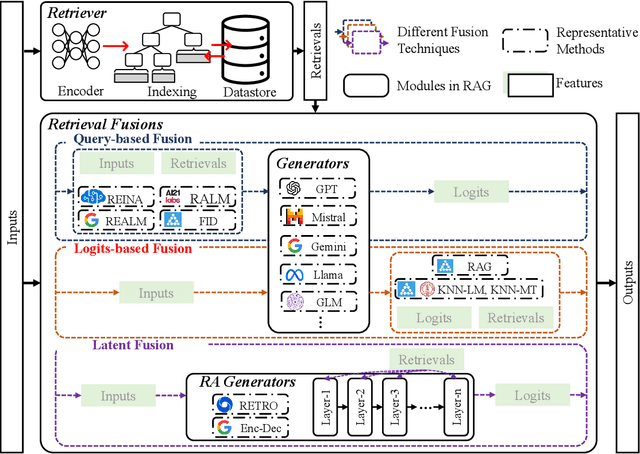
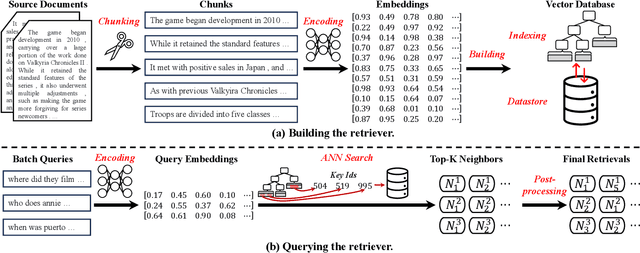

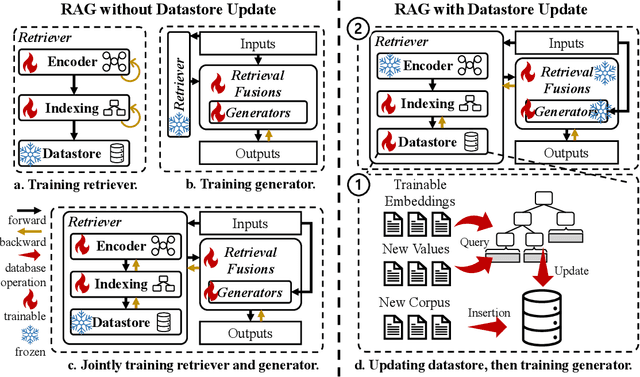
Abstract:Large language models (LLMs) have demonstrated great success in various fields, benefiting from their huge amount of parameters that store knowledge. However, LLMs still suffer from several key issues, such as hallucination problems, knowledge update issues, and lacking domain-specific expertise. The appearance of retrieval-augmented generation (RAG), which leverages an external knowledge database to augment LLMs, makes up those drawbacks of LLMs. This paper reviews all significant techniques of RAG, especially in the retriever and the retrieval fusions. Besides, tutorial codes are provided for implementing the representative techniques in RAG. This paper further discusses the RAG training, including RAG with/without datastore update. Then, we introduce the application of RAG in representative natural language processing tasks and industrial scenarios. Finally, this paper discusses the future directions and challenges of RAG for promoting its development.
Design Editing for Offline Model-based Optimization
May 22, 2024



Abstract:Offline model-based optimization (MBO) aims to maximize a black-box objective function using only an offline dataset of designs and scores. A prevalent approach involves training a conditional generative model on existing designs and their associated scores, followed by the generation of new designs conditioned on higher target scores. However, these newly generated designs often underperform due to the lack of high-scoring training data. To address this challenge, we introduce a novel method, Design Editing for Offline Model-based Optimization (DEMO), which consists of two phases. In the first phase, termed pseudo-target distribution generation, we apply gradient ascent on the offline dataset using a trained surrogate model, producing a synthetic dataset where the predicted scores serve as new labels. A conditional diffusion model is subsequently trained on this synthetic dataset to capture a pseudo-target distribution, which enhances the accuracy of the conditional diffusion model in generating higher-scoring designs. Nevertheless, the pseudo-target distribution is susceptible to noise stemming from inaccuracies in the surrogate model, consequently predisposing the conditional diffusion model to generate suboptimal designs. We hence propose the second phase, existing design editing, to directly incorporate the high-scoring features from the offline dataset into design generation. In this phase, top designs from the offline dataset are edited by introducing noise, which are subsequently refined using the conditional diffusion model to produce high-scoring designs. Overall, high-scoring designs begin with inheriting high-scoring features from the second phase and are further refined with a more accurate conditional diffusion model in the first phase. Empirical evaluations on 7 offline MBO tasks show that DEMO outperforms various baseline methods.
Large Language Model (LLM) for Telecommunications: A Comprehensive Survey on Principles, Key Techniques, and Opportunities
May 17, 2024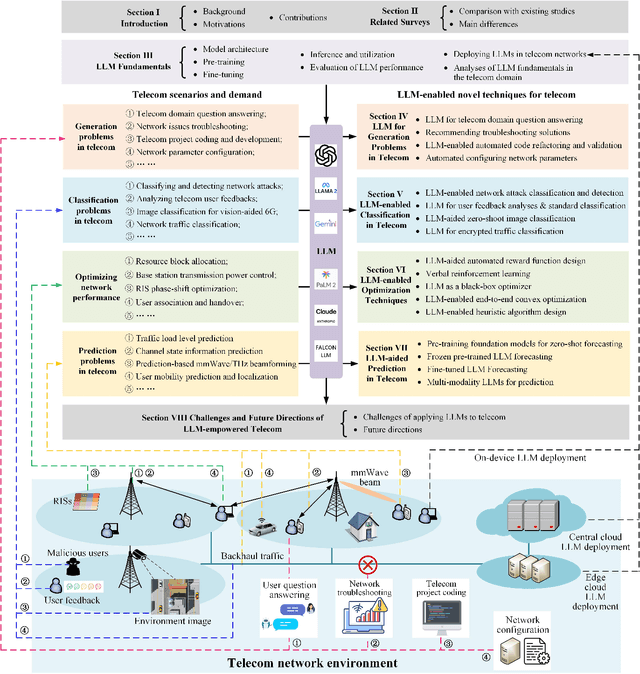
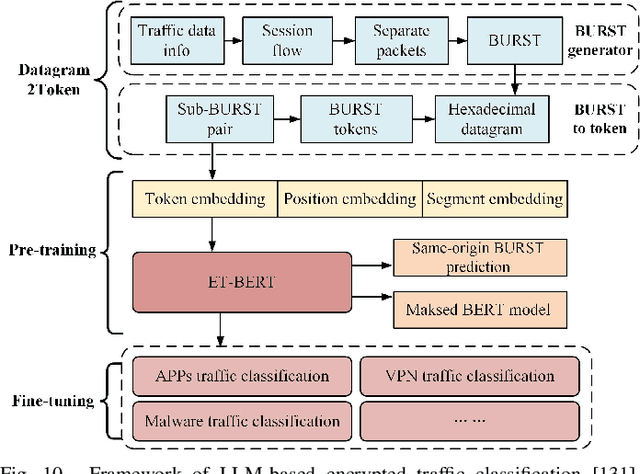
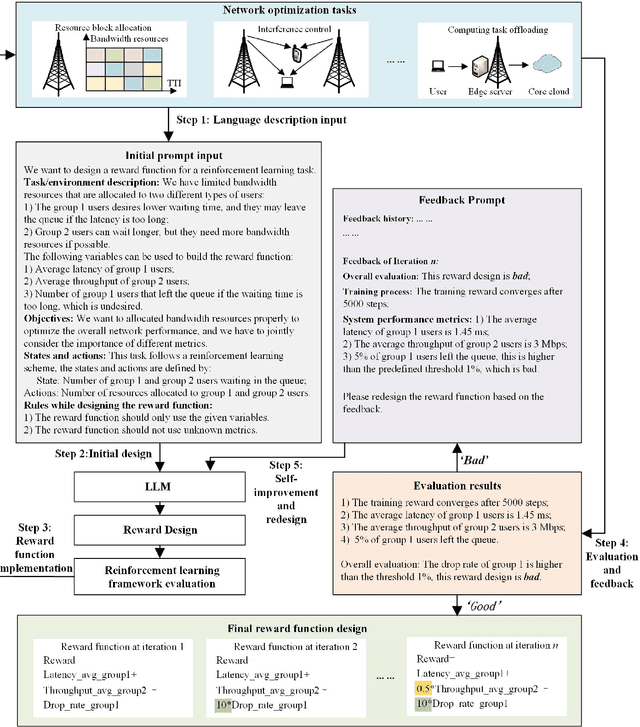
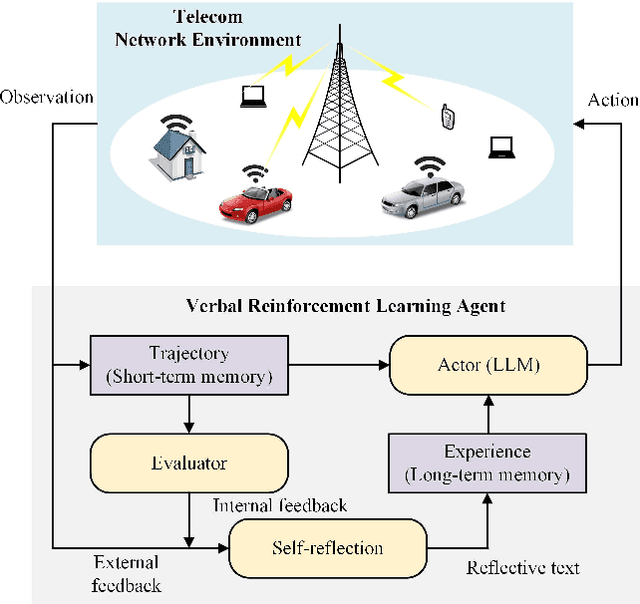
Abstract:Large language models (LLMs) have received considerable attention recently due to their outstanding comprehension and reasoning capabilities, leading to great progress in many fields. The advancement of LLM techniques also offers promising opportunities to automate many tasks in the telecommunication (telecom) field. After pre-training and fine-tuning, LLMs can perform diverse downstream tasks based on human instructions, paving the way to artificial general intelligence (AGI)-enabled 6G. Given the great potential of LLM technologies, this work aims to provide a comprehensive overview of LLM-enabled telecom networks. In particular, we first present LLM fundamentals, including model architecture, pre-training, fine-tuning, inference and utilization, model evaluation, and telecom deployment. Then, we introduce LLM-enabled key techniques and telecom applications in terms of generation, classification, optimization, and prediction problems. Specifically, the LLM-enabled generation applications include telecom domain knowledge, code, and network configuration generation. After that, the LLM-based classification applications involve network security, text, image, and traffic classification problems. Moreover, multiple LLM-enabled optimization techniques are introduced, such as automated reward function design for reinforcement learning and verbal reinforcement learning. Furthermore, for LLM-aided prediction problems, we discussed time-series prediction models and multi-modality prediction problems for telecom. Finally, we highlight the challenges and identify the future directions of LLM-enabled telecom networks.
Diffusion-based Contrastive Learning for Sequential Recommendation
May 15, 2024



Abstract:Contrastive learning has been effectively applied to alleviate the data sparsity issue and enhance recommendation performance.The majority of existing methods employ random augmentation to generate augmented views of original sequences. The learning objective then aims to minimize the distance between representations of different views for the same user. However, these random augmentation strategies (e.g., mask or substitution) neglect the semantic consistency of different augmented views for the same user, leading to semantically inconsistent sequences with similar representations. Furthermore, most augmentation methods fail to utilize context information, which is critical for understanding sequence semantics. To address these limitations, we introduce a diffusion-based contrastive learning approach for sequential recommendation. Specifically, given a user sequence, we first select some positions and then leverage context information to guide the generation of alternative items via a guided diffusion model. By repeating this approach, we can get semantically consistent augmented views for the same user, which are used to improve the effectiveness of contrastive learning. To maintain cohesion between the representation spaces of both the diffusion model and the recommendation model, we train the entire framework in an end-to-end fashion with shared item embeddings. Extensive experiments on five benchmark datasets demonstrate the superiority of our proposed method.
Towards Group-aware Search Success
Apr 26, 2024



Abstract:Traditional measures of search success often overlook the varying information needs of different demographic groups. To address this gap, we introduce a novel metric, named Group-aware Search Success (GA-SS). GA-SS redefines search success to ensure that all demographic groups achieve satisfaction from search outcomes. We introduce a comprehensive mathematical framework to calculate GA-SS, incorporating both static and stochastic ranking policies and integrating user browsing models for a more accurate assessment. In addition, we have proposed Group-aware Most Popular Completion (gMPC) ranking model to account for demographic variances in user intent, aligning more closely with the diverse needs of all user groups. We empirically validate our metric and approach with two real-world datasets: one focusing on query auto-completion and the other on movie recommendations, where the results highlight the impact of stochasticity and the complex interplay among various search success metrics. Our findings advocate for a more inclusive approach in measuring search success, as well as inspiring future investigations into the quality of service of search.
Structured Entity Extraction Using Large Language Models
Feb 06, 2024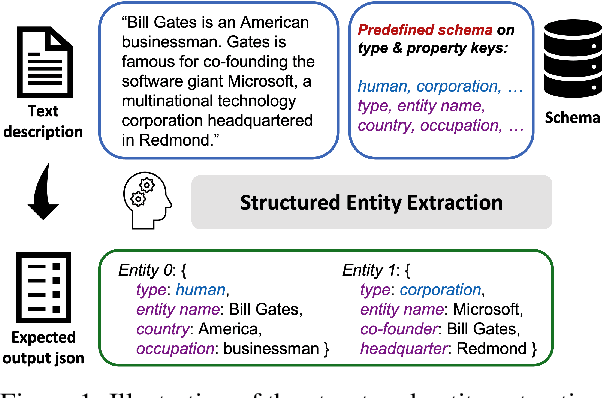



Abstract:Recent advances in machine learning have significantly impacted the field of information extraction, with Large Language Models (LLMs) playing a pivotal role in extracting structured information from unstructured text. This paper explores the challenges and limitations of current methodologies in structured entity extraction and introduces a novel approach to address these issues. We contribute to the field by first introducing and formalizing the task of Structured Entity Extraction (SEE), followed by proposing Approximate Entity Set OverlaP (AESOP) Metric designed to appropriately assess model performance on this task. Later, we propose a new model that harnesses the power of LLMs for enhanced effectiveness and efficiency through decomposing the entire extraction task into multiple stages. Quantitative evaluation and human side-by-side evaluation confirm that our model outperforms baselines, offering promising directions for future advancements in structured entity extraction.
Less or More From Teacher: Exploiting Trilateral Geometry For Knowledge Distillation
Jan 01, 2024



Abstract:Knowledge distillation aims to train a compact student network using soft supervision from a larger teacher network and hard supervision from ground truths. However, determining an optimal knowledge fusion ratio that balances these supervisory signals remains challenging. Prior methods generally resort to a constant or heuristic-based fusion ratio, which often falls short of a proper balance. In this study, we introduce a novel adaptive method for learning a sample-wise knowledge fusion ratio, exploiting both the correctness of teacher and student, as well as how well the student mimics the teacher on each sample. Our method naturally leads to the intra-sample trilateral geometric relations among the student prediction ($S$), teacher prediction ($T$), and ground truth ($G$). To counterbalance the impact of outliers, we further extend to the inter-sample relations, incorporating the teacher's global average prediction $\bar{T}$ for samples within the same class. A simple neural network then learns the implicit mapping from the intra- and inter-sample relations to an adaptive, sample-wise knowledge fusion ratio in a bilevel-optimization manner. Our approach provides a simple, practical, and adaptable solution for knowledge distillation that can be employed across various architectures and model sizes. Extensive experiments demonstrate consistent improvements over other loss re-weighting methods on image classification, attack detection, and click-through rate prediction.
Density-based User Representation through Gaussian Process Regression for Multi-interest Personalized Retrieval
Nov 15, 2023Abstract:Accurate modeling of the diverse and dynamic interests of users remains a significant challenge in the design of personalized recommender systems. Existing user modeling methods, like single-point and multi-point representations, have limitations w.r.t. accuracy, diversity, computational cost, and adaptability. To overcome these deficiencies, we introduce density-based user representations (DURs), a novel model that leverages Gaussian process regression for effective multi-interest recommendation and retrieval. Our approach, GPR4DUR, exploits DURs to capture user interest variability without manual tuning, incorporates uncertainty-awareness, and scales well to large numbers of users. Experiments using real-world offline datasets confirm the adaptability and efficiency of GPR4DUR, while online experiments with simulated users demonstrate its ability to address the exploration-exploitation trade-off by effectively utilizing model uncertainty.
Teacher-Student Architecture for Knowledge Distillation: A Survey
Aug 08, 2023



Abstract:Although Deep neural networks (DNNs) have shown a strong capacity to solve large-scale problems in many areas, such DNNs are hard to be deployed in real-world systems due to their voluminous parameters. To tackle this issue, Teacher-Student architectures were proposed, where simple student networks with a few parameters can achieve comparable performance to deep teacher networks with many parameters. Recently, Teacher-Student architectures have been effectively and widely embraced on various knowledge distillation (KD) objectives, including knowledge compression, knowledge expansion, knowledge adaptation, and knowledge enhancement. With the help of Teacher-Student architectures, current studies are able to achieve multiple distillation objectives through lightweight and generalized student networks. Different from existing KD surveys that primarily focus on knowledge compression, this survey first explores Teacher-Student architectures across multiple distillation objectives. This survey presents an introduction to various knowledge representations and their corresponding optimization objectives. Additionally, we provide a systematic overview of Teacher-Student architectures with representative learning algorithms and effective distillation schemes. This survey also summarizes recent applications of Teacher-Student architectures across multiple purposes, including classification, recognition, generation, ranking, and regression. Lastly, potential research directions in KD are investigated, focusing on architecture design, knowledge quality, and theoretical studies of regression-based learning, respectively. Through this comprehensive survey, industry practitioners and the academic community can gain valuable insights and guidelines for effectively designing, learning, and applying Teacher-Student architectures on various distillation objectives.
 Add to Chrome
Add to Chrome Add to Firefox
Add to Firefox Add to Edge
Add to Edge